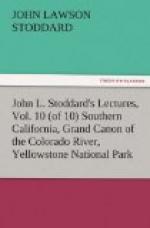It is a wonderful experience to ride for such a distance in a perfectly level valley, and see an uninterrupted range of mountains, eight thousand feet in height, rising abruptly from the plain like the long battle-line of an invading army. What adds to its impressiveness is the fact that these peaks are, for the entire country which they dominate, the arbiters of life and death. Beyond them, on one side, the desert stretches eastward for a thousand miles; upon the other, toward the ocean, whose moisture they receive and faithfully distribute, extends this valley of delight. The height of the huge granite wall is generally uniform, save where, like towers on the mighty rampart, old San Antonio and the San Bernardino Brothers lift their hoary heads two miles above the sea,—their silvery crowns and dazzling features standing out in the crystalline clearness of the atmosphere as if they had been carved in high relief.
[Illustration: An adobe house.]
[Illustration: A Pasadena lemon tree.]
We sped along, with feelings alternating between elation and dejection, as the scenery was beautiful or barren, till, suddenly, some sixty miles from Los Angeles, our train drew up before a city, containing asphalt pavements, buildings made of brick, and streets embowered in palms. This city which, in 1872, was a sheep-ranch, yet whose assessed valuation, in 1892, was more than four million dollars, is called Riverside; but, save in the rainy season, one looks in vain for the stream from which it takes its name. The river has retired, as so many western rivers do, to wander in obscurity six feet below the sand. “A providential thing,” said a wag to me, “for, in such heat as this, if the water rose to the surface it would all evaporate.” The sun was, indeed, ardent as we walked through the town, and we were impressed by the fact that the dwellings most appropriate for this region are those which its first settlers seem to have instinctively adopted; for the white, one-storied adobe house, refreshing to the eye, cool in the heat, warm in the cold, caressed by clinging vines and overhung with trees, is surely the ideal residence for Southern California. Such buildings can, of course, be greatly varied and embellished by wealthy owners; but modern houses of red brick, fanciful “Queen Annes,” and imitations of castles, seem less suited to this land of sun and sand, where nothing is so much to be desired as repose in form and color. I always welcomed, therefore, genuine southern dwellings and, in the place of asphalt pavements, natural roadways domed by arching trees.
[Illustration: A house modeled after the old Mexican fashion.]
[Illustration: The ideal home.]
The pride of Riverside is its far-famed Magnolia Avenue, fifteen miles in length, with two broad driveways lined with pepper and eucalyptus trees. Beyond these also are palm-girt sidewalks twenty feet in breadth; while, here and there, reflecting California’s golden sunshine from their glistening leaves, stand groups of the magnificent magnolias which give the avenue its name.




